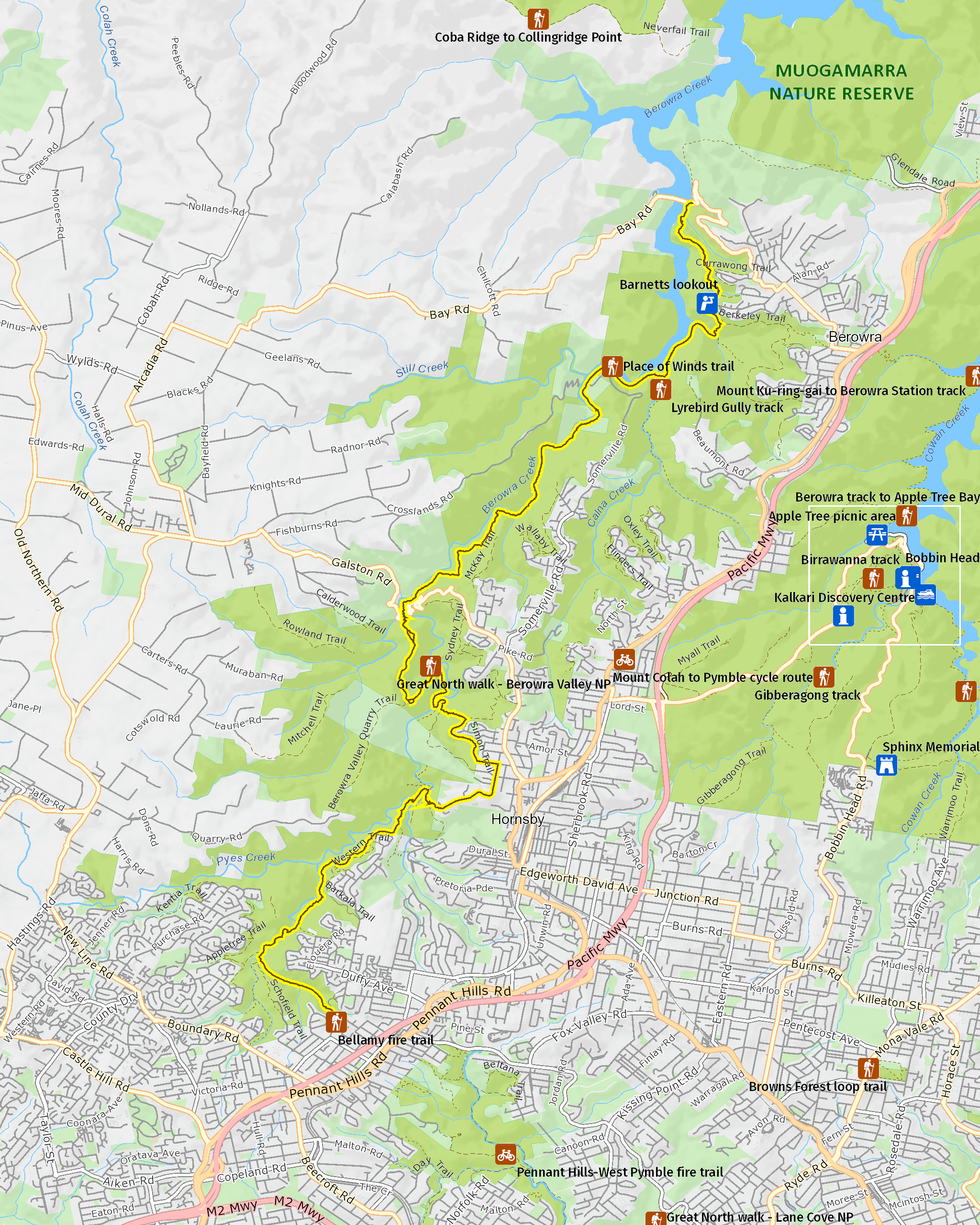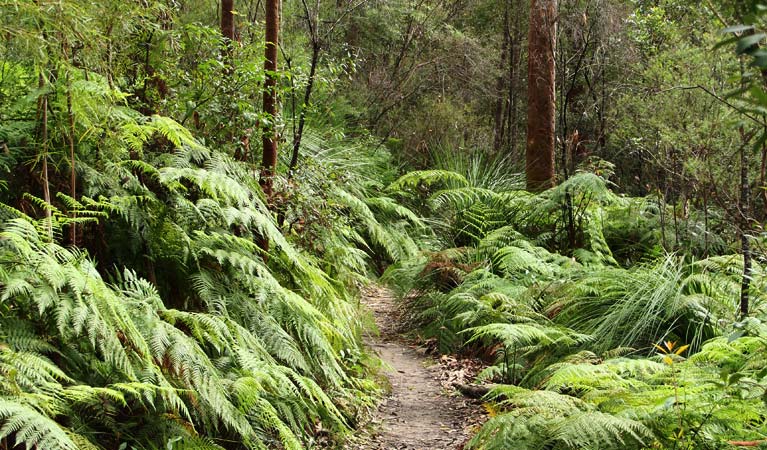Great North walk - Berowra Valley National Park
Berowra Valley National Park
Overview
Also known as Benowie walking track, this section of the iconic Great North walk between Sydney and Newcastle makes a great overnight hike or day walk. Camp out the night for an unforgettable bushland adventure.
- Accessibility
- No wheelchair access
- Distance
- 27km one-way
- Time suggested
- 3 - 4 days
- Grade
- Grade 5
- Trip Intention Form
-
It's a good idea to let someone know where you're going. Fill in a trip intention form to send important details about your trip to your emergency contact.
- Please note
- There's no access through Hornsby Rifle Range, between Quarry trail and Tunks Ridge. For your safety, please respect 'no through' access and follow the Great North walk signs to Manor Road and Simon trail.
- If you're planning to stay at a campground managed by Crown Lands from 1 June 2020, you now need to fill out the Crown reserves camping registration form.
- Make sure you prepare well if you’re planning to walk overnight. Bring weather-appropriate gear, sunscreen and let someone know where you are going.
- Berowra creek is susceptible to pollution. Swimming should be avoided for three days after heavy rainfall or if the water is discoloured.
Also known as Benowie walking track, this beautiful bushland walk through Berowra Valley National Park follows Berowra Creek for 27km of the iconic Great North walk between Sydney and Newcastle.
This section of the walk, from Pennant Hills to Berowra Waters, takes about 2 to 3 days to walk, with several places to camp along the way. If you’d prefer a shorter walk, you can always break the trail up into more manageable sections, especially if you're taking the kids out for the day.
Join the walk from Pennant Hills, Westleigh, Hornsby, Galston Gorge picnic area or Berowra Waters, and head out into the bush for an adventure. There's no public access through Hornsby Rifle Range, between Quarry trail and Tunks Ridge, or from Stewart Avenue park entrance. Please follow the signs to continue Great North walk via Manor Road in Hornsby and Simon trail.
For a longer walk extend your trip south along the Great North walk - Lane Cove National Park or link up with the Great North walk – Ku-ring-gai Chase National Park and continue north towards Newcastle.
Also see
-

Bellamy fire trail
Bellamy fire trail is a northern Sydney secret. This short walk through Berowra Valley Regional Park connects Pennant Hills and Thornleigh along a dog-friendly bushland trail.
-

Place of Winds interpretive trail
Take a walk along the Place of Winds interpretive trail. It’s an easy walk along the boardwalk over salt marsh and through woodland, featuring some scenic views over the valley.
-

Barnetts lookout
This very accessible lookout offers scenic views across the Berowra Valley and the waters of Berowra Creek. It’s a great spot for a picnic lunch.
Map

Map legend

Local alerts
For the latest updates on fires, closures and other alerts in this area, see https://www.nationalparks.nsw.gov.au/things-to-do/walking-tracks/great-north-walk-berowra-valley-national-park/local-alerts
General enquiries
- National Parks Contact Centre
- 7am to 7pm daily
- 1300 072 757 (13000 PARKS) for the cost of a local call within Australia excluding mobiles
- parks.info@environment.nsw.gov.au
Park info
- in Berowra Valley National Park in the Sydney and surrounds region
- Berowra Valley National Park is always open but may have to close at times due to poor weather or fire danger
- Crosslands Reserve is open 8am to 7.30pm during daylight savings and 9am to 5pm the rest of the year
- Barnetts Road Reserve and the lookout is closed from sunset to sunrise
Visitor info
All the practical information you need to know about Great North walk - Berowra Valley National Park.
Maps and downloads
Learn more
Great North walk - Berowra Valley National Park is in Berowra Valley National Park. Here are just some of the reasons why this park is special:
Aboriginal importance

Berowra Valley National Park is within the traditional Country of the Dharug People to the west. It contains a number of significant Aboriginal heritage sites, including artefacts, middens and campfire sites. This special area, with its land and waterways, plants and animals, features in all facets of Aboriginal culture and continues to be of great significance to Aboriginal people today.
Bush in the 'burbs

Eucalypt forests, delightful birdlife and all manner of creatures occupy this very beautiful bush valley stretching from the suburbs out towards the Hawkesbury river. While you're in the park, keep your eye out for a powerful owl, sea eagle, wedgetail, or listen for the call of a red crown toadlet.
Making tracks

Great North walk is an iconic track that stretches 250km from Sydney to Newcastle. Constructed in 1988 as part of the Australian Bicentenary, the walk takes in diverse landscapes and a lot of Australian history. Part of the walk travels through Berowra Valley National Park along the Benowie walking track.
Wonderful waterways

Berowra Creek is a hidden waterway perfect for canoeing, boating and fishing. Escape the noise and traffic of the city and come and while away a few hours in the perfect serenity of this lovely little spot. Load up your pack with sandwiches and hats and take the family for a wander along the trails or laze under a tree at Crosslands Reserve while the kids play.
Plants and animals protected in this park
Animals
-

Kookaburra (Dacelo novaeguineae)
Of the 2 species of kookaburra found in Australia, the laughing kookaburra is the best-known and the largest of the native kingfishers. With its distinctive riotous call, the laughing kookaburra is commonly heard in open woodlands and forests throughout NSW national parks, making these ideal spots for bird watching.
-

Superb lyrebird (Menura novaehollandiae)
With a complex mimicking call and an elaborate courtship dance to match, the superb lyrebird is one of the most spectacular Australian animals. A bird watching must-see, the superb lyrebird can be found in rainforests and wet woodlands across eastern NSW and Victoria.
-

Swamp wallaby (Wallabia bicolor)
The swamp wallaby, also known as the black wallaby or black pademelon, lives in the dense understorey of rainforests, woodlands and dry sclerophyll forest along eastern Australia. This unique Australian macropod has a dark black-grey coat with a distinctive light-coloured cheek stripe.
Plants
-

Old man banksia (Banksia serrata)
Hardy Australian native plants, old man banksias can be found along the coast, and in the dry sclerophyll forests and sandstone mountain ranges of NSW. With roughened bark and gnarled limbs, they produce a distinctive cylindrical yellow-green banksia flower which blossoms from summer to early autumn.

